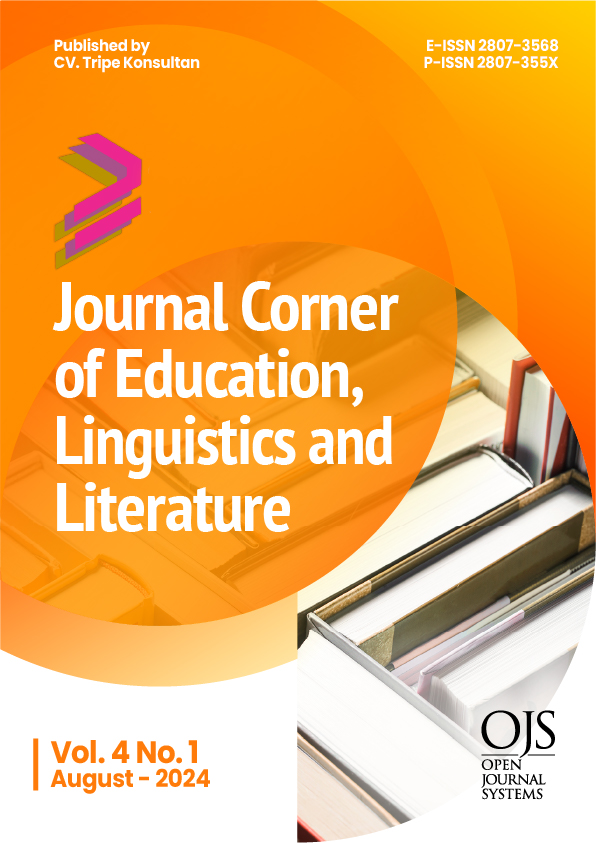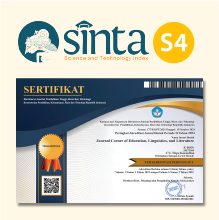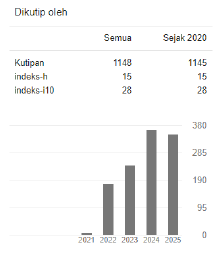The Intertwined Dialogues of Peace and Forgiveness in Uncle Tom's Cabin
 https://doi.org/10.54012/jcell.v4i1.281
https://doi.org/10.54012/jcell.v4i1.281
 Abstract views: 231
Abstract views: 231
 PDF downloads: 164
PDF downloads: 164
Keywords:
ethics, forgiveness, peace, Uncle Tom’s CabinAbstract
Crimes and peace are interdependent yet paradoxical to each other. The absence of crime can affect peace, accuracy and vice versa. This two-sided paradox can in fact be reconciled through forgiveness as a door to wider freedom. In Uncle Tom's Cabin novel, Tom forgives Legree, Sambo, and Quimbo who tortured him to death. Tom does not avenge violence with violence but with forgiveness. When Tom almost died, Legree did not care about his condition. In reverse, Sambo and Quimbo were impressed by Tom's heart and turned to take care of him. Tom's forgiveness shows ethical intention of others as in Levinas's thought, promise of peace and wider freedom in the sense of Ricoeur, and possibility of the heterogeneity of everyday life according to de Certeau. Tom's forgiveness at once shows everyone, no matter how small he is, can forgive others. This allows further reconciliation in a reciprocal way. Circle of violence can be cut off by forgiveness that heals others. Briefly, Tom is a reflection of peace in the form of forgiveness. Forgiveness means healing others, widening the circle of freedom of others, and as a promise of peace. Forgiveness can open itself up to reconciliation by promising freedom for a new life.
Downloads
References
Annasai, A. A., Putri, D. A., Wijaya, K., & Pasopati, R. U. (2024). Theory of
Patience as Reflected on Ralph Ellison's The King of Bingo Game.
Intertwine: Journal of English Language, Literary, and Cultural Studies, 1(2), 61-72.
Baghi, F. (2015). Politik Pengampunan.
kupang.tribunnews.com/2015/03/11/politik- pengampunan.
Bertens, K. (1985). Filsafat Barat Abad XX: Prancis. Jakarta: Gramedia.
de Certeau, M. (1984). The Practice of Everyday Life. Berkeley: University of
California Press.
Fahnani, R. D., Pujimahanani, C., & Pasopati, R. U. (2023). The Truth of
Redemption and Purification in Islam as Exposed in What I’ve Done Song by Linkin Park. In Proceeding International Conference on Religion, Science and Education (Vol. 2, pp. 827-834).
Fikri, F. (2022). Women and Blackness: Reader-Responses to Uncle Tom's Cabin
by Harriet Beecher Stowe (Doctoral dissertation, Universitas Andalas).
Fitriani, N. A., Millenia, P. A., Sarmi, N. N., & Pasopati, R. U. (2023). The Inquiries
of Racial Violence on Lauryn Hill’s Black Rage. Intertwine: Journal of English Language, Literary, and Cultural Studies, 1(1), 1-12.
Govier, T. (2017). Forgiveness and the Unforgivable. American Philosophical
Quarterly, 36(1), 59-75.
Hakam, F. F. (2022). The Portrayal of Slavery in Harriet Beecher Stowe's Uncle
Tom's Cabin (Doctoral dissertation, Universitas Hasanuddin).
Haryatmoko. (2009). Kekhasan Moral Kristiani: Ideologis atau Epistemologis?.
Orientasi Baru, 18 (2), 111-127.
Hidayat, M. A., Suyanto, B., Sugihartati, R., Sirry, M. I., & Srimulyo, K. (2020).
Sociomental of Intolerance: Explaining the Socio Cognitive Dimensions
of Religious Intolerance Among Indonesian Youths. Talent Development & Excellence, 12(1).
Horowski, J. (2022). Harm, Forgiveness and the Subjectivity of the Victim.
Philosophia, 50(3), 1175-1188.
Horowski, J., & Kowalski, M. (2022). Human Health and Christianity in the
Context of the Dilemma of Forgiveness. Journal of religion and health,
(2), 1282-1299.
Kamengwa, C. N., & Egunjobi, J. P. (2022). The Concept of Forgiveness and its
Social Cultural Significance among Tabwa People of Congo.
Oktafiani, A. P., Ibrahim, L. N., & Pasopati, R. U. (2023). THE COMPLEXITIES OF INTERPERSONAL CONFLICTS AS REFLECTED IN ERNEST HEMINGWAY’S THE KILLERS. TANDA: Jurnal Kajian Budaya, Bahasa dan Sastra (e-ISSN: 2797-0477), 3(01), 29-41.
Pasopati, R., Yuliastuti, A., & Pujimahanani, C. (2022). PREMEDITATIO
MALORUM AND DISSEMINATION OF HOPE IN POST-PANDEMIC
RECOVERY. The Sunan Ampel Review of Political and Social Sciences, 1(2), 82-95.
Rahmayanti, A. (2020). The representation of racial discrimination in Harriet
Beecher Stowe's novel Uncle Tom's Cabin (Doctoral dissertation, UIN Sunan Gunung Djati Bandung).
Ricoeur, P. (1992). Oneself as Another. Chicago:University of Chicago Press.
Sarmi, N. N., Suyaji, F. I. M., & Pasopati, R. U. (2023). REVENGE AS MIMETIC
DESIRE IN JUAN RULFO’S TELL THEM NOT TO KILL ME!. PARADIGM: Journal of Language and Literary Studies, 6(2).
Sinambela, J., Sinaga, J., & Purba, B. C. (2023). Recognition of Sins, the Way of
Forgiveness and Purification Through Jesus Christ Based on 1 John 1: 9.
International Journal of Scientific Multidisciplinary Research, 1(1), 35-46.
Stowe, H. B. (1852). Uncle Tom's Cabin. Boston: John P. Jewett.
utc.iath.virginia.edu/uncletom/utfihbsa40t.html.
Tjaya, T. H. (2012). Enigma Wajah Orang Lain: Menggali Pemikiran Emmanuel
Levinas. Jakarta: Gramedia.
Wilhelm, J. (2020). " All the Fervor of a Camp-Meeting": Race and Revivalism in
Uncle Tom's Cabin. Papers on Language and Literature, 56(2), 107-221.
Yuliastuti, A., & Pasopati, R. U. (2023). The Features of Temptation and
Redemption as Implied in Hans Christian Andersen’s The Red Shoes. In Proceeding International Conference on Religion, Science and Education (Vol. 2, pp. 477-486).
Zimmermann, J. (2012). Humanism and Religion: A Call for the Renewal of
Western Culture. Oxford: Oxford University Press.
Downloads
Published
How to Cite
Issue
Section
License
Copyright (c) 2024 Rommel Utungga Pasopati, Johanes Claudio Perdana Napitupulu, Komang Sinta Puspayani, Ni Putu Nia Damayanti, Maulidia Nur Faulina

This work is licensed under a Creative Commons Attribution-ShareAlike 4.0 International License.
All articles published in the Journal Corner of Education, Linguistics, and Literature are licensed under the Creative Commons Attribution-ShareAlike License (CC BY-SA).

















